Blank B.E., Krantz S.G. Calculus: Single Variable
Подождите немного. Документ загружается.


investigate a method of evaluating Riemann integrals that does not require the
elaborate and tedious algebra used to solve Example 7.
QUICK QUIZ
1. Calculate
P
3
j5 0
cosðjπ=4 Þ.
2. Calculate
P
3
j5 0
ð2j 1 j
2
1 2
j
Þ.
3. What is the fifth subinterval of [3, 9] when the uniform partition of order 7 is
used?
4. What is the right endpoint approximation of the area of the region under the graph
of y 5 1/x and over the interval [1, 2] when the uniform partition of order 3 is used?
Answers
1. 1 2. 41 3. [45/7, 51 /7] 4. 37/60
EXERCISES
Problems for Practice
c In Exercises 1210, write out the sum, and perform the
addition. b
1.
P
4
j5 1
3j
2.
P
6
j5 0
ð2j 2 1Þ
3.
P
5
j5 2
ð22j
2
Þ
4.
P
6
‘5 4
‘=ð‘ 2 3Þ
5.
P
5
n5 2
2n=ðn 2 1Þ
6.
P
4
k5 2
ðk
3
2 6kÞ
7.
P
6
m5 3
ð2m
2
2 3mÞ
8.
P
5
j5 1
j sinðjπ=2Þ
9.
P
3
j5 1
j sin
2
ðjπ=6Þ
10.
P
4
j5 0
1=ð2j 2 3Þ
c In Exercises 11216, use summation notation to express
the
sum. b
11. 2 1 3 1 4 1 5 1 6
12. 3 1 6 1 9 1 12 1 15
13. 9 1 13 1 17 1 21 1 25 1 29
14. 9 1 16 1 25 1 36
15. 1/4 1 1/5 1 1/6 1 1/7 1 1/8
16. 2/5 1 3/7 1 4/9 1 5/11
c Use formulas (5.1.4) and (5.1.5) to calculate the sums in
Exercises 17222. b
17.
P
12
j5 1
j
2
18.
P
12
j5 1
ðj
2
2 4Þ
19.
P
12
j5 1
ðj
2
1 2jÞ
20.
P
10
j5 1
ð3j
2
1 2j 1 1Þ
21.
P
24
j5 12
ð3j 2 2Þ
22.
P
16
j5 7
ð2j
2
2 21jÞ
c In Exercises 23226, use an identity to simplify the sum. b
23.
P
19
j5 0
expðjÞ
24.
P
5
j5 0
2
2j21
3
j11
25.
P
6
j5 2
lnðjÞ
26.
P
27
j5 7
ln
j 1 1
j
c In each of Exercises 27238, calculate the right endpoint
approximation
of the area of the region that lies below the
graph of the given function f and above the given interval I of
the x-axis. Use the uniform partition of given order N. b
27. f (x) 5 x
2
2 2xI5 [3, 5], N 5 2
28. f (x) 5 1/xI5 [2, 3], N 5 2
29. f (x) 52log
2
(x) I 5 [1/2, 1], N 5 2
30. f (x) 5 2x
2
1 1 I 5 [0, 9/2], N 5 3
31. f (x) 5 2 1 sin (2x) I 5 [π/2, 2π], N 5 3
32. f (x) 5 4 2 3 cos (x) I 5 [0, 4π], N 5 3
33. f (x) 5 x/(x 1 1) I 5 [24, 22], N 5 4
34. f (x) 5 2x/(2x 2 1) I 5 [23, 21], N 5 4
35. f (x) 5 x sin (x) I 5 [2π, π], N 5 4
36. f (x) 5 sec
(x) I 5 [2π/3, π/3], N 5 4
37. f (x) 5 x
3
2 6x 1 6 I 5 [21, 5/2], N 5 7
38. f (x) 5 x 1 cos (2x) I 5 [0, 3π], N 5 6
Further Theory and Practice
c Suppose that f (x) $ 0 for x in I 5 [a, b]. If for each sub-
interval [x
j21
, x
j
] that arises from the uniform partition
P 5 fx
0
, x
1
, ...,x
N
g of I, we use the left endpoint x
j21
instead
5.1 Introduction to Integration—The Area Problem 385

of the right endpoint in formula (5.1.9), then we obtain the
left endpoint approximation
X
N
j5 1
f ðx
j21
ÞΔx
of the area A of the region below the graph of f and above I (see
Figure 10). As can be seen from Figure10, if f in
creases on I,then
the right endpoint approximation overestimates A, and the left
endpoint approximation underestimates A. In each of Exercises
39244, calculate the average of the left and right endpoint
a
pproximations. (For purposes of comparison, the exact value of
A is given. Notice that your answer is more accurate than both
the left and right endpoint approximations.) b
39. f (x) 5 sin
(x) I 5 [0, π/3], N 5 2, A 5 1/2
40. f (x) 5 2 1 tan (x) I 5 [2π/4, π/4], N 5 2, A 5 π
41. f (x) 5 (2x 1 1)/(x 1 1) I 5 [0, 2], N 5 2, A 5 4 2 ln(3)
42. f (x) 5 1 1 x
3
I 5 [21, 3], N 5 3, A 5 24
43. f (x) 5 1 2 1/x
2
I 5 [1, 2], N 5 3, A 5 1/2
44. f (x) 5 16
x
I 5 [0, 1], N 5 4, A 5 15/ln(16)
45. Following the technique from Example 7, calculate the
area of the region that lies below the graph of f (x) 5
4 2 x
2
and above the interval [0, 2] of the x-axis.
46. Following the technique from Examples 6 and 7, show that
the area of the region that lies below the graph of f (x) 5
x
2
1 x and above the interval [1, 4] of the x-axis is 57/2.
47. Find p such that e
p
5 e e
2
e
3
...e
100
. Find q so that
lnðqÞ5
P
100
n5 1
lnðnÞ.
48. Calculate the sum S 5
P
N
j5 1
ð2j 2 1Þ of the first N odd
positive integers.
49. Calculate the sum S 5
P
N
j5 1
ð2jÞ
2
of the first N even
positive square integers. Subtract your value of S from the
value of
P
2N
j5 1
j
2
to calculate the sum
P
N
j5 1
ð2j2 1Þ
2
of the
first N odd positive square integers.
50. Which is larger,
P
N
j5 1
j
2
or
P
N
2
j5 1
j? Explain why.
51. Suppose that fa
j
g
N
j5 0
is a sequence of real numbers.
Suppose that M and N are integers such that 0 , M , N.
Show that
X
N
j5 M
ða
j
2 a
j21
Þ5 a
N
2 a
M21
:
Hint: Look at the cases N 5 M 1 1 and N 5 M 1 2to
determine the pattern.
52. Evaluate 1/2 1 1/6 1 1/12 1 1 1/(1000 1001) by writ-
ing the j th term as
1
j ðj 1 1Þ
5
1
j
2
1
j 1 1
and using Exercise 51.
53. Write
S 5 1 1 2 1 3 1 1 N
forward and backward:
S 5 1 1 2 1 1 N
S 5 N 1 N 2 1 1 1 1:
2S 5 N 1 1 1 N 1 1 1 1 N 1 1
Add vertically. Derive formula (5.1.4) by solving for S.
54. Derive formula (5.1.4) by noticing that
X
N
j5 1
ð2j 2 1Þ5
X
N
j5 1
ðj
2
2 ðj 2 1Þ
2
Þ:
Write the sum on the left in terms of S 5 1 1
2 1 3 1 1 N. Evaluate the sum on the right using
Exercise 51. Solve for S.
55. Derive formula (5.1.5) by noticing that
X
N
j5 1
ð3j
2
2 3j 1 1Þ5
X
N
j5 1
ðj
3
2 ðj 2 1Þ
3
Þ:
Write the expression on the left as a combination of three
sums, one of which is 3S 5 3(1
2
1 2
2
1 3
2
1 1 N
2
). Use
formula (5.1.4) to evaluate
P
N
j5 1
3j. Evaluate the sum on
the right using Exercise 51. Solve for S.
56. Suppose that b . 0. Following the technique from Example
6, show that the area of the region that lies below the graph
of f (x) 5 x
2
and above the interval [0, b]ofthex-axis is b
3
/3.
57. Let f (x) 5 x
2
. Suppose that b . 0 and that F (x)isan
antiderivative of f (x). In this exercise, we will approximate
the area A of the region that lies below the graph of f and
above the interval I 5 [0, b]ofthex-axis. We will use one
rectangle with base I. For the height, we use f (c)wherec is
the point in (0, b) obtained by applying the Mean Value
Theorem to F on I—see Figure 11. Use Exercise 56 to
sh
ow that this approximation is, in fact, exact.
Right endpoint approximation
ax
j1
x
j
b
ax
j1
x
j
b
Left endpoint approximation
m Figure 10
386 Chapter
5 The Integral

58. Show that
X
N
j5 1
ð4j
3
2 6j
2
1 4j 2 1Þ5
X
N
j5 1
ðj
4
2 ðj2 1Þ
4
Þ:
Evaluate the sum on the right using Exercise 51. Write
the expression on the left as a combination of four sums,
one of which is 4S 5 3(1
3
1 2
3
1 3
3
1 1 N
3
). Use for-
mula (5.1.4) to evaluate
P
N
j5 1
4j. Use formula (5.1.5) to
evaluate
P
N
j5 1
6j
2
. Solve for S to obtain the identity
X
N
j5 1
j
3
5
NðN11Þ
2
2
:
59. Suppose 0 # a , b. Following the technique of Example 7,
use the formula from Exercise 58 to show that the area
under the curve y 5 xy5 x
3
from x 5 0tox 5 b is b
4
/4.
Deduce that the area under the curve y 5 x
3
from x 5 a to
x 5 b is (b
4
2 a
4
)/4.
60. Suppose m and k are positive constants. For f (x) 5
mx 1 k, let A (b) denote the area under the graph of f,
above the x-axis, and between x 5 0 and x 5 b. Calculate
A (b), and show that A
0
(b) 5 f (b).
61. For f (x) 5 x
2
, let A(b) denote the area under the graph of
f, above the x-axis, and between x 5 0 and x 5 b. Show
that A
0
(b) 5 f (b).
62. Notice that, in limit (5.4), lim
N-N
Δx 5 0. It may seem
that lim
N-N
P
N
j5 1
f ðx
j
ÞΔx 5 0 in view of the following
calculation:
lim
N-N
X
N
j5 1
f ðx
j
ÞΔx 5 lim
N-N
X
N
j5 1
f ðx
j
Þ lim
N-N
Δx
5
lim
N-N
X
N
j5 1
f ðx
j
Þ
0
5 0:
Explain what is wrong with this reasoning.
63. For any positive integer k, let
S
N
ðkÞ5 1
k
1 2
k
1 3
k
1 1 N
k
:
It is known that
S
N
ðkÞ5
1
k 1 1
N
k11
1 P
k
ðNÞ
where P
k
is a polynomial of degree k. Accept this fact
without proof (but notice that for k 5 1, 2, and 3, this
assertion follows from formula (5.1.4), formula (5.1.5),
and Exercise 58, respectively).
a. Show that lim
N-N
S
N
(k)/N
k11
5 1/(k 1 1).
b. Suppose 0 # a , b. Show that the area under the curve
y 5 x
k
from x 5 0tox 5 b is b
k11
/(k 1 1).
c. Deduce that the area under the curve y 5 x
k
from x 5 a
to x 5 b is (b
k11
2 a
k11
)/(k 1 1).
64. Calculate lim
N-N
ð1=NÞ
P
N
j5 1
ffiffiffiffiffiffiffiffiffiffiffiffiffiffiffiffiffiffiffiffiffiffi
1 2 ðj=NÞ
2
q
by identifying
this number as the limit of right endpoint approximations
of the area of a region with known area.
65. Let f :[0,a] - [0, b] be a continuous, increasing, onto func-
tion. Let A denote the area in the xy-plane that liesunder the
graph of y 5 f (x) and above the interval [0, a] of the x-axis.
What is the area in the yx-plane that lies under the graph of
x 5 f
2 1
( y) and above the interval [0, b]ofthey-axis?
66. Use Exercise 51 and the product formula
sinðAÞcosðBÞ5
1
2
sinðA 1 BÞ1 sinðA 2 BÞ
with A 5 t/2 and B 5 kt to show that
X
N
k5 1
sin
t
2
cosðktÞ5
1
2
sin
N 1
1
2
t
2 sin
1
2
t
:
Use this summation formula, together with the product
formula, with A 1 B 5 (N 1 1/2)t and A 2 B 52t/2 to
show that
X
N
k5 1
cosðktÞ5
sinðNt=2ÞcosððN 1 1Þt=2Þ
sinðt=2Þ
:
67. Suppose 0 , b # π /2. Use the last formula from Exercise 66
with t 5 b/N to show that the area of the region under
the graph of y 5 cos (x) and over the interval [0, b]
is sin (b).
Calculator/Computer Exercises
c In a computer algebra system, a right endpoint approxima-
tion can be implemented by means of a one-line command. For
example, if the real numbers a and b, the positive integer N, and
the function f, have been defined, then the command
evalfððbaÞ=N*addðfða1j*ðb2aÞ=NÞ; j51:: NÞÞ;
calculates formula (5.1.9) in Maple. In Exercises 68271,an
interval
[a, b], and a function f are given. The function is positive
C
y f(c)
c
b
x
y
y x
3
C
1
3
f
(c)
y x
2
m Figure 11
5.1 Introduction to Integration—The Area Problem 387
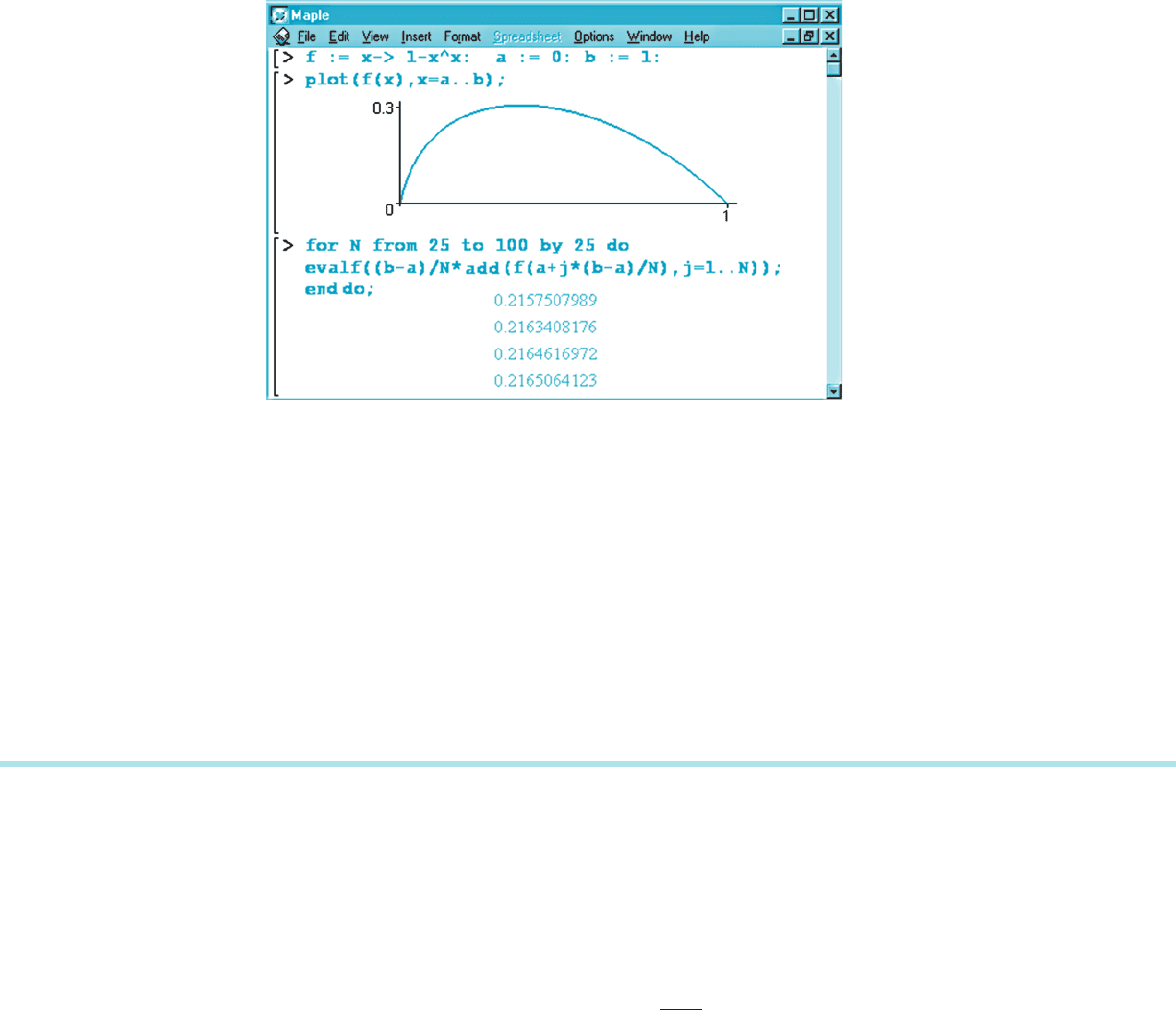
m Figure 12
on (a, b) and it is 0 at the endpoints. Approximate the area
under y 5 f (x) and over the interval [a, b] by using the right
endpoint approximation, starting with N 5 25. Increment N by
25 until the first two decimal places of the sum remain the same
for three consecutive calculations. Figure 12 shows a Maple
implementation for the function f (x) 5 1 2 x
x
,0# x # 1. (This
procedure does not guarantee two decimal places of accuracy.
Section 5.7 presents several methods that can be used to achieve
a prescribed accuracy.) b
68. f ðxÞ5
ffiffiffiffiffiffiffiffiffiffiffiffiffiffi
ffi
16 2 x
4
p
; 22 # x # 2
69. f ðxÞ5
ffiffiffi
x
p
2 x; 0 # x # 1
70. f ðxÞ5 ð2 2 x
2
Þ=ð2 1 x
2
Þ; 2
ffiffiffi
2
p
# x #
ffiffiffi
2
p
71. f ðxÞ5 sin
2
ðxÞ; 0 # x # π
c In each of Exercises 72275, locate the left x-intercept a
and
the right x-intercept b of the graph of the given function f.
Then follow the instructions for Exercises 68271. b
72. f ðxÞ5 1 1 2x 2 x
4
73. f ðxÞ5 2 1 x 2 exp ðxÞ
74. f ðxÞ5 10 2 x
2
2 1=x
3
75. f ðxÞ5 xexpð2x
2
Þ2 0:1
5.2 The Riemann Integral
We now define a mathematical operation on functions that captures the essence of the
method from Section 5.1, but that can be applied to several other situations as well.
Riemann Sums Let f be any function defined on the interval [a, b]. (We no longer assume that f is a
nonnegative function.) Let N be a positive integer. As in Section 5, the uniform
partition of order N of the interval [a, b] is the set of N 1 1 equally spaced points
x
j
5 a 1 j
b 2 a
N
ð0 # j # NÞ
that divides [a, b] into the N subintervals
I
1
5 ½x
0
; x
1
; I
2
5 ½x
1
; x
2
; :::; I
N
5 ½x
N21
; x
N
of equal length
388 Chapter 5 The Integral
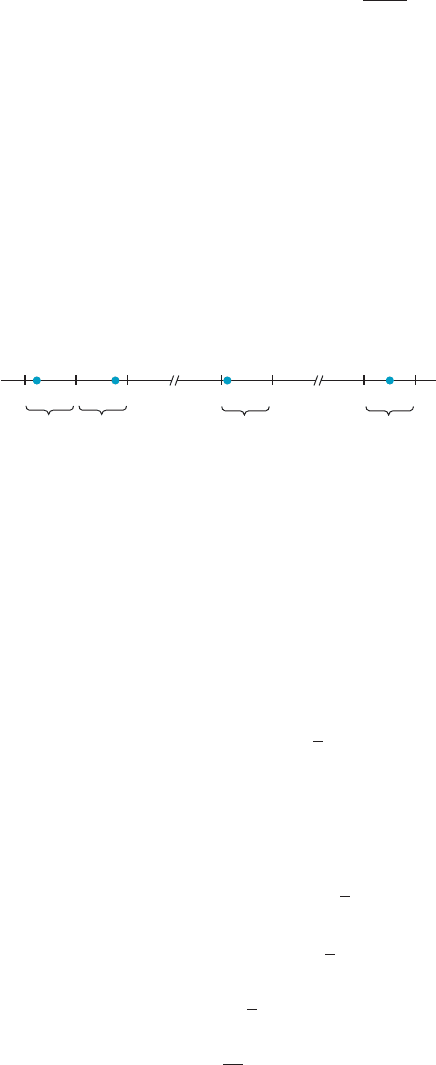
Δx 5
b 2 a
N
:
A choice of points S
N
associated with the uniform partition of order N is a sequence
s
1
, s
2
, ..., s
N
of points with s
j
in I
j
for each j. The point s
j
can be chosen arbitrarily
from the subinterval I
j
. Thus s
j
can be a right endpoint or a left endpoint or any
interior point. Figure 1 illustrates one possible choice of points. If S
N
is a choice of
points, then the expression
Rðf ; S
N
Þ5
X
N
j5 1
f ðs
j
ÞΔx ð5:2:1Þ
is called a Riemann sum of f. The notation R( f, S
N
) indicates that a Riemann sum
depends on the function f and the choice of points S
N
.
⁄ EX
AMPLE 1 Write a Riemann sum for the function f ( x ) 5 x
2
2 4 and the
interval [a, b] 5 [25, 3] using the partition f25, 23, 21, 1, 3g.
Solution Obser
ve that
I
1
5 ½25; 23; I
2
5 ½23; 21; I
3
5 ½21; 1 ; I
4
5 ½1; 3;
and Δx 5 2. To form a Riemann sum, we must first make a selection of points s
j
(1 # j
# 4) with s
j
in I
j
. According to the definition, we may select any point s
1
in I
1
, any
point s
2
in I
2
, and so on. Here is our arbitrary choice:
s
1
523 2 I
1
; s
2
52
3
2
2 I
2
; s
3
5 0 2 I
3
; s
4
5 1 2 I
4
:
The Riemann sum for this collection of points S
4
is
Rðf ; SÞ 5
X
4
j5 1
f ðs
j
ÞΔx
5 f ð23Þ2 1 f
2
3
2
2 1 f ð0Þ2 1 f ð1Þ2
5 ð9 2 4Þ2 1
9
4
2 4
2 1 ð0 2 4Þ2 1 ð1 2 4Þ2
5 10 2
7
2
2 8 2 6
52
15
2
:
Of course, a different choice of points s
1
, s
2
, s
3
, s
4
would lead to a different Rie-
mann sum.
¥
x
0
x
1
s
1
s
2
I
1
I
2
x
2
. . . . . .
x
j1
I
j
x
j
s
j
x
N1
I
N
s
N
x
N
m Figure 1
5.2 The Riemann Integral 389
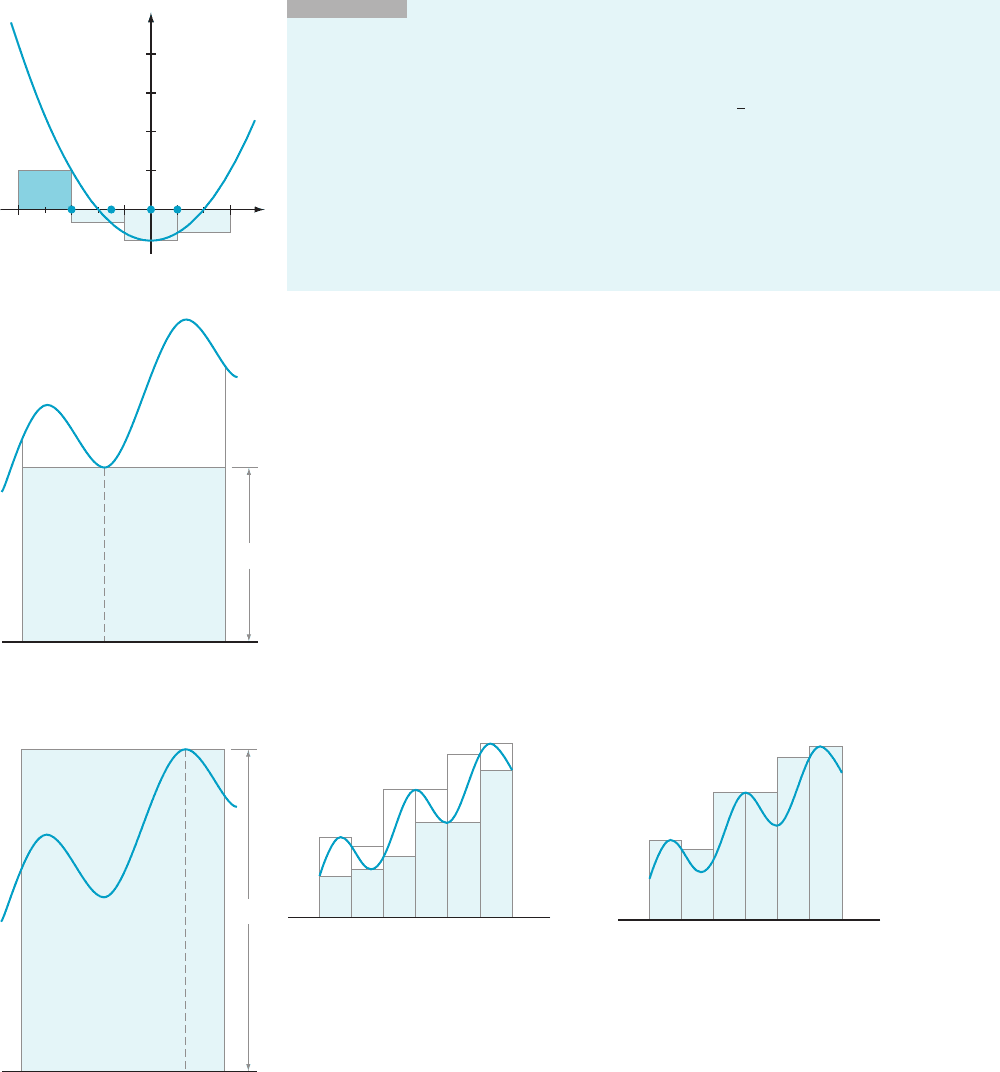
INSIGHT
Example 1 shows that a Riemann sum can be negative. If we must give
this Riemann sum a geometric meaning, then we can think of it as a difference of areas,
namely,
Rðf ; S
4
Þ5 10
|{z}
Area of rectangle
above x-axis
2
7
2
1 8 1 6
|fflfflfflfflfflfflfflfflfflffl{zfflfflfflfflfflfflfflfflfflffl}
Area of rectangles
below x-axis
:
See Figure 2. In later chapters, we will use Riemann sums to represent physical
quantities other than area. In those cases, it is usually not appropriate to associate
Riemann sums with the area concept.
Suppose that f is continuous. Let ‘
j
be a point in I
j
at which f attains its
minimum value on I
j
(see Figure 3a), and let u
j
be a point in I
j
at which f achieves its
maximum value on I
j
(see Figure 3b). The Extreme Value Theorem (Section 2.3, in
Chapter 3) guarantees that such points ‘
j
and u
j
exist. We denote the resulting
choices of points associated to the uniform partition by L
N
5 f‘
1
, ‘
2
, ...,‘
N
g and
U
N
5 fu
1
, u
2
, ...,u
N
g. The Riemann sums
Rðf ; L
N
Þ5
X
N
j5 1
f ð‘
j
ÞΔx
and
Rðf ; U
N
Þ5
X
N
j5 1
f ðu
j
ÞΔx
are respectively called the lower Riemann sum and upper Riemann sum of order N.
They are the least and greatest Riemann sums of order N, as we will prove in
Theorem 1. Figures 4 and 5 illustrate typical lower and upper Riemann sums.
⁄ EX
AMPLE 2 Consider the continuous function f ( x ) 5 x
2
2 4 on the
interval [25, 3] (as in Example 1). Find the upper and lower Riemann sums of
order 4.
Solution The
four equal-length subintervals of [25, 3] are I
1
5 [25, 23],
I
2
5 [23, 21], I
3
5 [21, 1], and I
4
5 [1, 3]. The graph of f is shown in Figure 6, in
which the four subintervals have been separated. By inspection, f attains its
x
y
20
15
10
5
35 3
m Figure 2
f(ᐉ
j
)
x
j1
x
j
ᐉ
j
m Figure 3a
f(u
j
)
x
j1
x
j
u
j
m Figure 3b
x
N
bx
1
x
j1
x
j
a x
0
m Figure 4 The area of the
shaded rectangles is a lower
Riemann sum.
x
N
bx
1
x
j1
x
j
a x
0
m Figure 5 The area of the
shaded rectangles is an upper
Riemann sum.
390 Chapter 5 The Integral
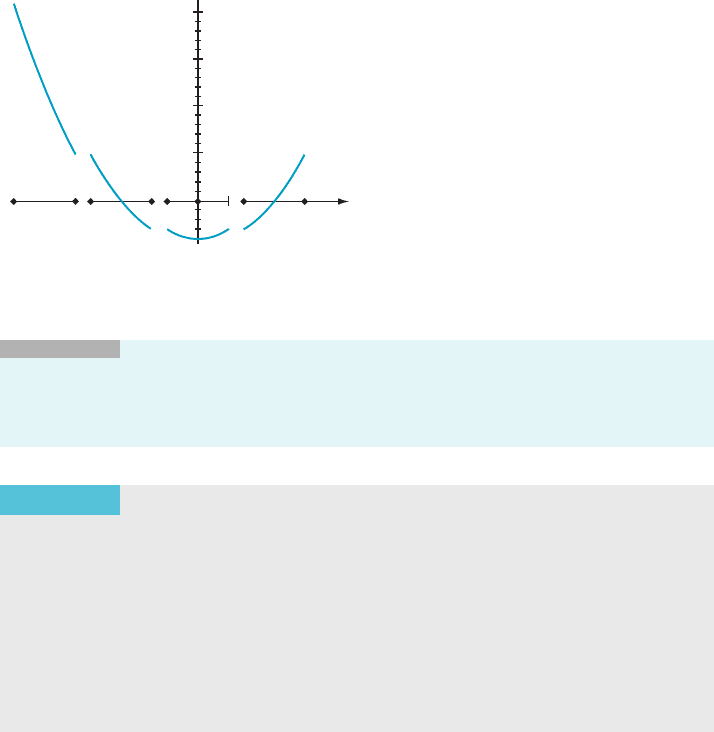
maximum value on I
1
at u
1
525 and its minimum value at ‘
1
523. Continuing to
the other three subintervals, we find that u
2
523, ‘
2
521, u
3
521, ‘
3
5 0, u
4
5 3,
and ‘
4
5 1. (Because f(x) is maximized on I
3
at both x 521andx 5 1, we could
equally well have set u
3
5 1.) Substituting these values into the formulas for the
upper and lower Riemann sums, we obtain
Rðf ; U
4
Þ 5
X
4
j5 1
f ðu
j
ÞΔx
5 f ð25Þ2 1 f ð23Þ2 1 f ð21Þ2 1 f ð3Þ2
5 2ð21 1 5 2 3 1 5Þ
5 56
and
Rðf ; L
4
Þ 5
X
4
j5 1
f ð‘
j
ÞΔx
5 f ð23Þ2 1 f ð21Þ2 1 f ð0Þ2 1 f ð1Þ2
5 2ð5 2 3 2 4 2 3Þ
5210:
INSIGHT
Notice that the Riemann sum R( f, S
4
) 5215/2 calculated in Example 1
lies between the upper and lower Riemann sums R( f, U
4
) 5 56 and R( f, L
4
) 5210,
which are calculated in Example 2. The following theorem generalizes this observation
and states another key fact about upper and lower Riemann sums.
THEOREM 1
Suppose that f is continuous on an interval [a, b].
a. If S
N
5 fs
1
, , s
N
g is any choice of points associated with the uniform
partition of order N, then
Rðf ; L
N
Þ# Rðf ; S
N
Þ# Rðf ; U
N
Þ: ð5:2:2Þ
b. The numbers R( f, L
N
) and R( f, U
N
) become arbitrarily close to each other
for N sufficiently large. That is,
lim
N-N
Rðf ; U
N
Þ2 Rðf ; L
N
Þ
5 0: ð5:2:3Þ
10
1
11 3
335
u
1
u
2
l
1
I
1
I
2
I
3
I
4
l
2
l
3
l
4
u
3
u
4
5
15
20
1
x
m Figure 6
5.2 The Riemann Integral 391

Proof. It follows from the definitions of ‘
j
and u
j
that
f ð‘
j
Þ# f ðs
j
Þ# f ðu
j
Þ
for every s
j
in I
j
. If we multiply each term by the positive quantity Δx and sum over
j 5 1, 2, . . . , N, then we obtain
X
N
j5 1
f ð‘
j
ÞΔx #
X
N
j5 1
f ðs
j
ÞΔx #
X
N
j5 1
f ðu
j
ÞΔx;
which is the assertion of Theorem 1a.
Theorem 1b appears to be plausible when we look at examples. Refer again to
Figures 4 and 5, which illustrate typical upper and lower Riemann sums. The area
of
the shaded rectangles in Figure 7 represents the difference R( f, U
N
) 2 R( f, L
N
)
for N 5 6. In Figure 8, we increase the number of subintervals to 30. Observe that
the difference between the upper and lower Riemann sums, again repres ented by
the area of the shaded rectangles, is significantly smaller. Theorem 1b follows from
an important property of contin uous functions on closed, bounded intervals.
According to that property, which is proved in texts on advanced calculus, given a
positive ε, there is a positive δ such that f (s) is within ε of f (t), provided that s and t
are points in [a, b] within δ of each other. If we take N large enough so that Δx 5
(b 2 a)/N , δ, then u
j
and ‘
j
are within δ of each other for each j. Therefore
0 # Rðf ; U
N
Þ2 Rðf ; L
N
Þ 5
X
N
j5 1
ðf ðu
j
Þ2 f ð‘
j
ÞÞ Δx ,
X
N
j5 1
ε Δx
5 ε
X
N
j5 1
Δx 5 ε ðb 2 aÞ:
Because ε is arbitrary, we have shown that R( f, U
N
) 2 R( f, L
N
) can be made
arbitrarily small by taking N sufficiently large, which is Theorem 1b. ’
The Riemann Integral In Section 5.1, we defined the area under the graph of a positive function to be the
limit as N tends to infinity of right endpoint approximations. This definition will be
the basis of our limit definition for general Riemann sums.
DEFINITION
Suppose that f is a function defined on the interval [a, b]. We say
that the Riemann sums R( f, S
N
) tend to the real number ‘ (or that ‘ is the limit
of the Riemann sums R( f, S
N
)) as N tends to infinity, if, for any ε . 0, there is a
positive integer M such that
jRðf ; S
N
Þ2 ‘j, ε
for all N greater than or equal to M and any choice of S
N
. If this is the case, we
say that f is integrable on [a, b], and we denote the limit ‘ by the symbol
Z
b
a
f ðxÞdx:
This numerical quantity is called the Riemann integral of f on the interval [a, b].
The operation of going from the function f to the number
R
b
a
f ðxÞdx is called
integration.
x
6
bx
1
x
2
x
3
x
4
x
5
a x
0
m Figure 7 The total area
enclosed by the shaded rectangles
is Rðf ; U
6
Þ2 Rðf ; L
6
Þ.
a
b
m Figure 8 The area of the
shaded region decreases as the
number N of subdivisions
increases.
392 Chapter 5 The Integral

Let us examine the components of the notation for the Riemann integral. The
elongated “S” symbol is called the integral sign and is used to remind us that the
integral is a limit of sums. The left and right endpoints of the interval [a, b]
are called the limits of integration. We refer to a as the lower limit of integration and
b as the upper limit of integration. The expression f (x) is called the integrand. For
now, the expression dx serves only to remind us of the variable of integration. We
may think of dx as the infinitesimal limit of Δx as Δx tends to zero. In later work,
dx will be a useful device for helping us transform integrals into new integrals.
Only the presence of limits of integration serves to distinguish the Riemann
integral
R
b
a
f ðxÞdx from the indefinite integral
R
f ðxÞdx from Section 4.9 (in Chapter
4). To emphasize the distinction, we sometimes refer to the Riemann integral
R
b
a
f ðxÞdx as a definite integral. As the nearly identical notations for
R
f ðxÞdx
and
R
b
a
f ðxÞdx suggest, there is an important relatio nship between the two
types of integrals. Later in this section, we learn that indefinite integrals may be
used to calculate definite integrals. First, we state a theorem that assures the
existence of the definite integral
R
b
a
f ðxÞdx for most of the functions that we
encounter in calculus .
THEOREM 2
If f is continuous on the interval [a, b], then f is integrable on [ a , b].
That is, the Riemann integral
R
b
a
f ðxÞdx exists.
Proof. The
proof of this assertion involves technical details that are best left to a
text on advanced calculus. The following simple observations, however, give a good
idea of what is involved. Suppose f is increasing and positive on [a, b]. The areas of
the shaded regions in Figures 9a, 9b, and 9c represent R( f, L
N
) for N 5 1, 2, 4. The
amount by which R( f, L
2
) exceeds R( f, L
1
) is represented by the area of the
rectangle that lies above the dashed line in Figure 9b. Similarly, the amount by
which R( f, L
4
) exceeds R( f, L
2
) is represented by the area of the rectangles that lie
above the dashed lines in Figure 9c. If we continue to bisect each subinterval, we
obtain an increasing sequence of lower Riemann sums that is bounded above by
ab
f(b)
( f,
1
)
m Figure 9a
ab
( f,
2
)
m Figure 9b
ab
( f,
4
)
m Figure 9c
5.2 The Riemann Integral 393
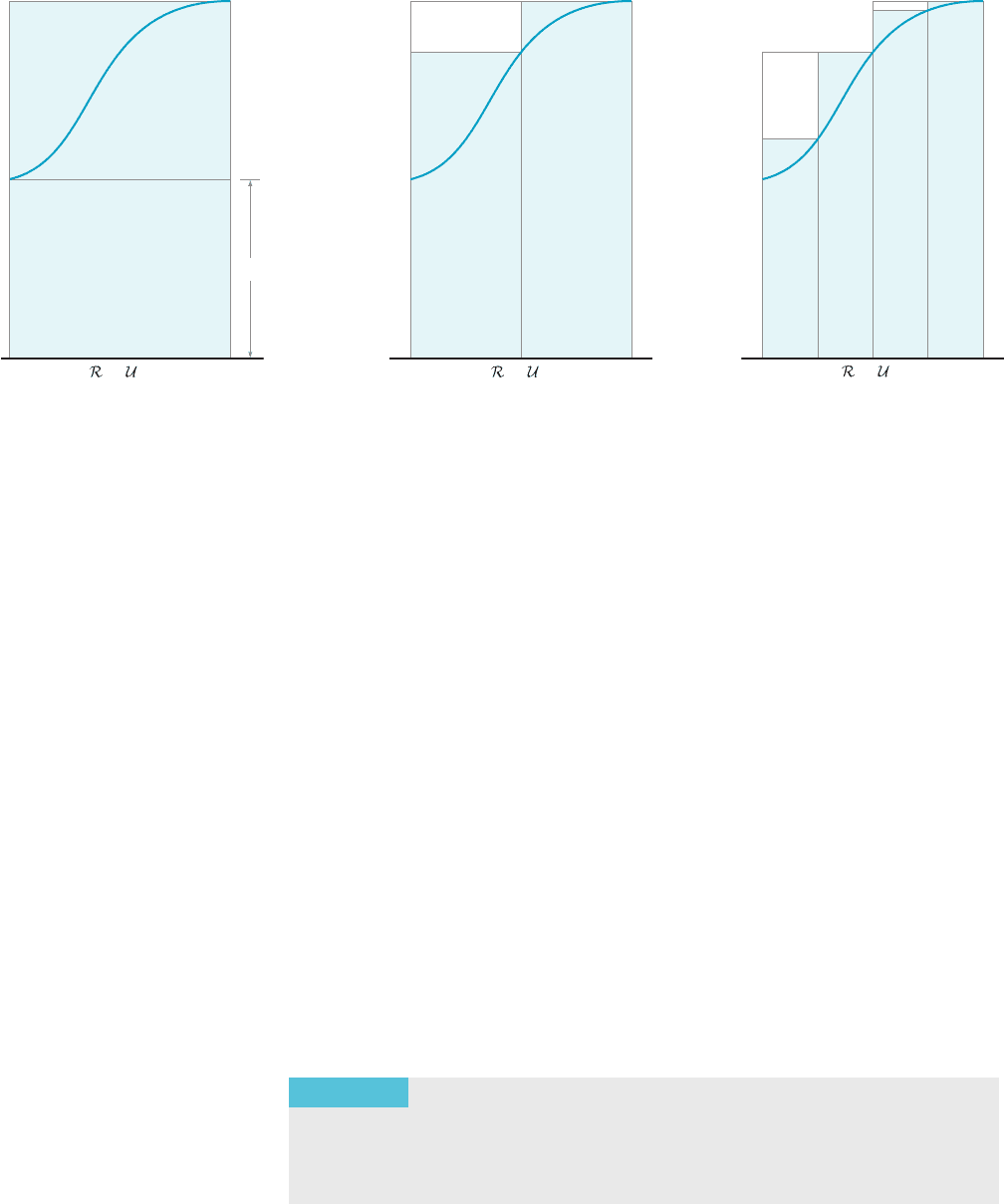
f (b) (b 2 a) (the area of the circumscribed rectangle shown in Figure 9a). We also
obtain a decreasing sequence of upper Riemann sums that is bounded below by
f (a) (b 2 a), as shown in Figure 10. According to the Monotone Convergence
Property of the real numbers (Section 2.6 in Chapter 2), both sequences of upper
and lower Riemann sums converge. We infer from limit (5.2.3) that the sequences
must converge to the same number. Call this common limit ‘. Let ε be an arbitrary
positive numbe r. Because the sequences fR( f, L
N
)g and fR( f, U
N
)g converge to ‘,
there is an integer M such that 0 # ‘ 2 R( f, L
N
) , ε/2 and 0 # R( f, U
N
) 2 ‘ , ε/2
for all N with M # N. Using inequality (5.2.2), we see that, for every N with M # N
and any choice of points S
N
,wehave
jRðf ; S
N
Þ2 ‘j # Rðf ; U
N
Þ2 Rðf ; L
N
Þ
5 Rðf ; U
N
Þ2 ‘ 1 ‘ 2 Rðf ; L
N
Þ
5 ε=2 1 ε=2
5 ε;
which shows that f has a Riemann integral on the interval [a, b]. ’
Calculating Riemann
Integrals
Calculating definite integrals by the method of Riemann sums is tedious and usually
difficult. Fortunately, our next theorem shows how indefinite integrals, or anti-
derivatives, can be used to evaluate definite integrals without considering Riemann
sums. Recall from Section 4.9 in Chapter 4 that F is an antiderivative of f on an open
interval (a, b)ifF
0
(x) 5 f (x) for all x in (a, b). If we say that F is an antiderivative of f
on the closed interval [a, b], then we mean that F is continuous on [a, b]andF
0
5 f on
(a, b). As you read the proof of Theorem 3, notice how crucial it is to have flexibility
in the choice of points fs
j
g that we use to form the Riemann sums.
THEOREM 3
Suppose that F is an antiderivative of a continuous function f on
[a, b]. Then,
Z
b
a
f ðxÞdx 5 FðbÞ2 FðaÞ: ð5:2:4Þ
ab
( f,
1
)
f(a)
m Figure 10a
ab
( f,
2
)
m Figure 10b
ab
( f,
4
)
m Figure 10c
394 Chapter
5 The Integral
